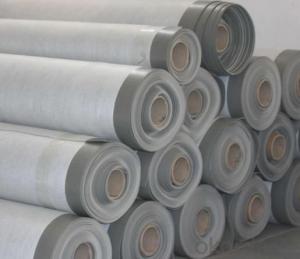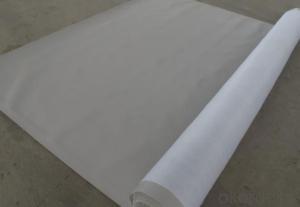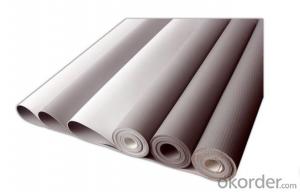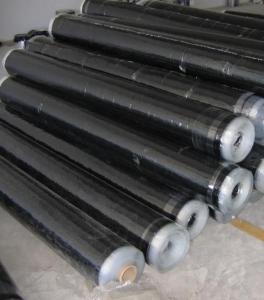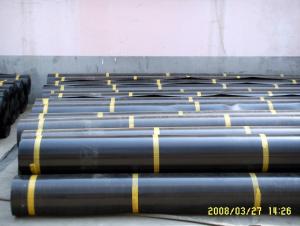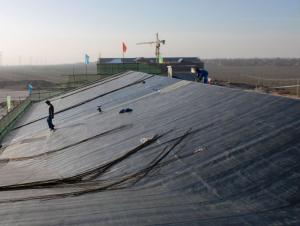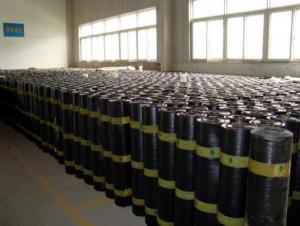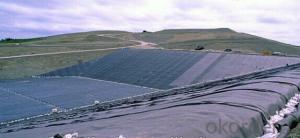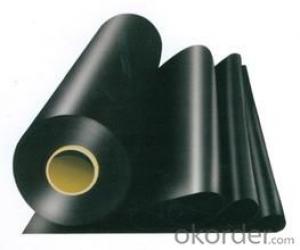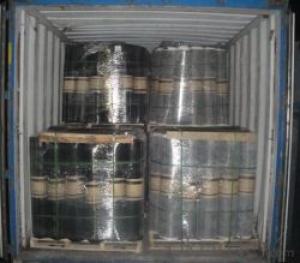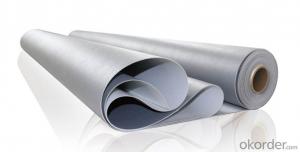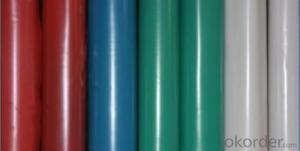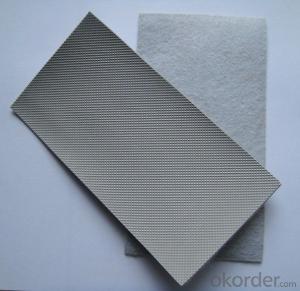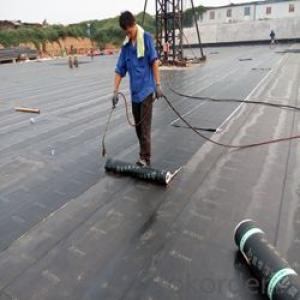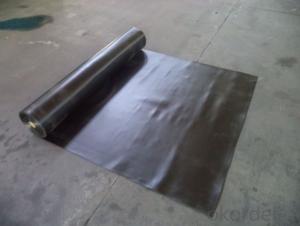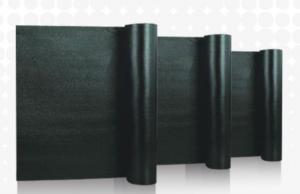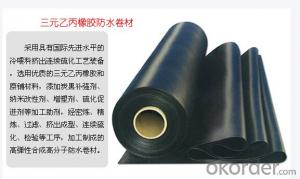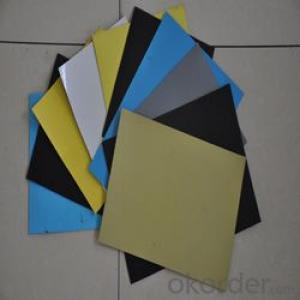PVC Waterproofing Membrane for Underground Leakage Proof
- Loading Port:
- China main port
- Payment Terms:
- TT OR LC
- Min Order Qty:
- 5000 m²
- Supply Capability:
- 100000 m²/month
OKorder Service Pledge
OKorder Financial Service
You Might Also Like
Features of PVC Waterproofing Membrane:
Excellent anti-aging property.
Puncture- resistant.
Welding construction,
High tensile strength, good elongation, good dimensional stability.
Good plasticity.
It has self-extinguishing from fire property.
Materials surface is smooth, fast color, stain resistance.
More wide, Wastage become less when being used.
Specification of PVC Waterproofing Membrane:
No. | Item | Model Ⅱ | |
1 | Tensile Strength Mpa ≥ | 12.0 | |
2 | Elongation at break% ≥ | 250 | |
3 | Shrinkage rate % ≤ | 2.0 | |
4 | Flexibility at low temperature | No crackle at -25oC | |
5 | Water tightness | Watertight | |
6 | Puncture resistance | Watertight | |
7 | Heat aging treatment | Appearance | Free from bubble, crack, cohesion and void |
Change rate of tensile strength % | +20oC | ||
Change rate of elongation at break | |||
Flexibility at low temperature | No crack at -20oC | ||
8 | Chemical corrosion resistance | Change rate of tensile strength % | +20 |
Change rate of elongation at break | |||
Flexibility at low temperature | No crack at -20oC | ||
9 | Artificial weathering | Change rate of tensile strength % | +20 |
Change rate of elongation at break | |||
Flexibility at low temperature | No crack at -20oC | ||
Remark: The property of artificial weathering might not be applicable to non-exposed product | |||
Physical Property
1. Exposed to sunshine: UV rays resistance, long service life and aging resistance
2. Easy installation and dimensional stability: can be wieldable under wide range of temperature and experience minus dimensional change in thermal treatment
3. High tensile strength and elongation thus can accommodate movements of substrates
4.Good flexibility under low temperature, good adaptability to ambient temperature difference
5, Secure anti-puncture and good rooting resistance, no pollution caused to environment when being welded and good waterproofing choice for plant roofs
6. Good plasticity: convenient and fast treatment of detailed parts of corners and edges
Product usage
Different kinds of Pvc waterproof membrane can variously be used to the roof building, underground building,tunnel,dam,pool,sewage treatment works,garbage disposal facilities.It also can be suitable to any requirement of all kinds of technological practice&different grade of roof waterproof and underground constructions waterproof.
FAQ of PVC Waterproofing Membrane
a.Can we get some samples before place order?
Answer: We can send the free samples to you by freight collect.
b.How many years can your PVC membrane guarantee?
Answer: We will guarantee the quality for 5 years at least.
c.Which countries you ever export the product?
Answer: We export the PVC membrane to South Africa, Middle east and even European countries.
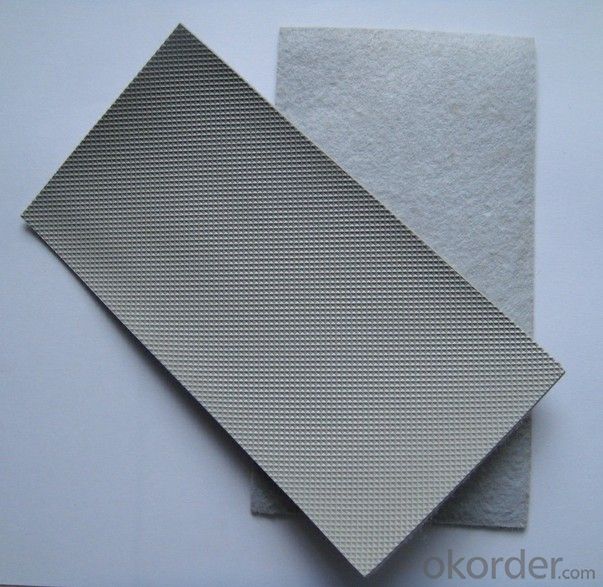
- Q: Can a waterproofing membrane be used on insulation surfaces?
- Indeed, one can apply a waterproofing membrane to insulation surfaces. In fact, it is often advised to incorporate a waterproofing membrane above insulation as an extra layer of defense against water infiltration. This is particularly crucial in areas where moisture poses a concern, such as basements, roofs, or exterior walls. The waterproofing membrane functions as a barricade, preventing water from permeating the insulation and causing harm. It also aids in preserving the insulation's integrity and effectiveness by keeping it dry. Furthermore, certain waterproofing membranes have the added advantage of enhancing the insulation's energy efficiency by reducing air leakage and heat transfer. All in all, utilizing a waterproofing membrane on insulation surfaces is an intelligent and practical solution to safeguard your building or home from water damage.
- Q: Can a waterproofing membrane be used on bridges?
- Yes, a waterproofing membrane can be used on bridges. It is a common practice to use waterproofing membranes on bridge decks to protect them from water infiltration, which can cause damage and deterioration over time. The membrane acts as a barrier, preventing water from penetrating the bridge deck and protecting the underlying structure.
- Q: Can a waterproofing membrane be used in swimming pools or water features?
- Yes, a waterproofing membrane can be used in swimming pools or water features. Waterproofing membranes are specifically designed to prevent water leakage and can effectively seal and protect the surfaces of pools and water features from water damage.
- Q: Can a waterproofing membrane be used for underground utilities?
- Yes, a waterproofing membrane can be used for underground utilities. Waterproofing membranes are designed to provide a barrier against water penetration, protecting the underlying structure from moisture damage. This can be particularly important for underground utilities, as they are constantly exposed to the surrounding soil and potential water seepage. By applying a waterproofing membrane to underground utilities, such as water pipes, sewer lines, or electrical conduits, it helps prevent water infiltration and subsequent corrosion or degradation of the materials. The membrane acts as a protective layer, keeping the utilities dry and free from moisture-related issues. There are various types of waterproofing membranes available, including sheet membranes, liquid membranes, and spray-applied membranes, each with its own unique properties and installation methods. The choice of membrane will depend on factors such as the specific utility, surrounding soil conditions, and any additional requirements such as chemical resistance or structural reinforcement. It is important to note that proper installation and maintenance of the waterproofing membrane are crucial for its effectiveness. The membrane should be installed by trained professionals, following manufacturer guidelines and industry best practices. Regular inspections and maintenance should also be carried out to ensure the membrane remains intact and functional over time. In summary, a waterproofing membrane can indeed be used for underground utilities, offering protection against water infiltration and preserving the integrity and longevity of the utilities.
- Q: Can a waterproofing membrane be used on storage tanks?
- Yes, a waterproofing membrane can be used on storage tanks. Waterproofing membranes are designed to create a barrier that prevents water or other liquids from penetrating through the surface they are applied to. When applied to storage tanks, these membranes can provide protection against leaks, corrosion, and damage caused by moisture. They are commonly used in various industries, including oil and gas, chemical, and water treatment, to ensure the integrity and longevity of storage tanks. Additionally, waterproofing membranes can be tailored to meet specific requirements, such as resistance to chemicals, UV exposure, or high temperatures, making them suitable for a wide range of storage tank applications.
- Q: Are waterproofing membranes resistant to corrosion?
- Yes, waterproofing membranes are resistant to corrosion. These membranes are specifically designed to provide a barrier against water, moisture, and other corrosive elements. They are made from materials that are not prone to corrosion, such as synthetic polymers like PVC or TPO, or rubberized asphalt. These materials have excellent resistance to water and moisture, as well as to chemicals and other corrosive substances. Therefore, when properly installed and maintained, waterproofing membranes can effectively protect structures against corrosion and extend their lifespan.
- Q: Can a waterproofing membrane be applied to tiled surfaces?
- Yes, a waterproofing membrane can be applied to tiled surfaces. In fact, it is common practice to use a waterproofing membrane underneath tiled surfaces, especially in areas prone to moisture such as bathrooms, showers, and kitchen backsplashes. The waterproofing membrane acts as a barrier to prevent water penetration into the substrate, protecting the tiles and the underlying structure from water damage. It is important to ensure that the tiled surface is properly prepared and free from any cracks or damage before applying the waterproofing membrane to achieve optimal results.
- Q: Can a waterproofing membrane be used in conjunction with green building practices?
- Yes, a waterproofing membrane can definitely be used in conjunction with green building practices. In fact, incorporating a waterproofing membrane into the construction of a green building can help enhance its overall sustainability and efficiency. One of the key principles of green building practices is to maximize energy efficiency and reduce the environmental impact of a building. By installing a waterproofing membrane, the building's envelope can be protected from moisture intrusion, preventing water damage and potential mold growth. This, in turn, helps maintain the structural integrity of the building, reducing the need for repairs and replacements, which can be resource-intensive and generate waste. Additionally, a waterproofing membrane can contribute to better indoor air quality. By preventing water infiltration, it helps create a dry and healthy living or working environment, minimizing the risk of respiratory issues and other health problems associated with dampness. Furthermore, a waterproofing membrane can improve the energy efficiency of a building. By preventing water from seeping into the walls or foundation, it reduces the potential for heat loss through moisture evaporation, thus reducing the energy needed for heating and cooling. This can lead to reduced energy consumption and lower carbon emissions, aligning with the goals of green building practices. It is important, however, to choose a waterproofing membrane that is environmentally friendly and meets green building standards. Look for membranes that are made from recycled or sustainable materials and have low VOC (volatile organic compound) content. Additionally, consider selecting a membrane that is designed for durability and longevity, as this can further reduce the environmental impact by minimizing the need for replacement over time. In conclusion, a waterproofing membrane can be a valuable addition to any green building project. It helps protect the building envelope, improves indoor air quality, and enhances energy efficiency. By selecting an environmentally friendly membrane, the overall sustainability of the building can be further improved.
- Q: Can a waterproofing membrane be used on nickel surfaces?
- Yes, a waterproofing membrane can be used on nickel surfaces. Waterproofing membranes are commonly used in construction and building projects to protect surfaces from water damage and moisture intrusion. They create a barrier that prevents water from penetrating through the surface and causing damage. Nickel surfaces, like any other metal surfaces, can be susceptible to corrosion and damage from water exposure. By applying a waterproofing membrane, the nickel surface can be effectively protected from water and moisture, extending its lifespan and maintaining its integrity. However, it is important to ensure that the specific waterproofing membrane being used is suitable for application on nickel surfaces. Different membranes may have different compatibility requirements, so it is recommended to consult with the manufacturer or a professional to ensure proper application and compatibility.
- Q: Can a waterproofing membrane be used in conjunction with tile or stone installations?
- Yes, a waterproofing membrane can be used in conjunction with tile or stone installations.
Send your message to us
PVC Waterproofing Membrane for Underground Leakage Proof
- Loading Port:
- China main port
- Payment Terms:
- TT OR LC
- Min Order Qty:
- 5000 m²
- Supply Capability:
- 100000 m²/month
OKorder Service Pledge
OKorder Financial Service
Similar products
Hot products
Hot Searches
Related keywords
